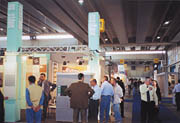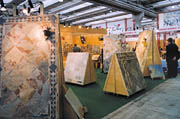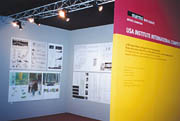

The show featured a total of 1,445 exhibitors, including 480 international firms from 52 different nations. The total for the international sector represents an increase of 14.3% over 2000, and participation increased by 147 companies overall. Although attendance figures were not released as of press time, Veronafiere, the event organizer, estimates that the total was over 50,000, despite a drop-off in visitors from the U.S. and the Middle East. In previous years, North American attendance at the event had increased significantly, and this trend is expected to resume in 2002.
Stone suppliers used the fair to showcase a broad range of products, including blocks, slabs, tiles and specialty work such as statuary and furnishings. And in addition to introducing new products and design patterns -- including several varieties of antiqued mosaics -- stone suppliers also used the event to promote existing products. Once again, natural stone with an aged look ruled the day, such as materials furnished with a "brushed" finish. And to better illustrate the "brushing" technique to visitors, several exhibitors were prepared to offer a detailed explanation of how the finish is created, complete with the actual brushes used during the process.
On the machinery end, the exhibit halls of Marmomacc saw a number of new equipment introductions and modifications to existing machinery. There were also advances in the "consumables" end, with improvements on items such as diamond polishing pads and edging wheels. Additionally, new formulations for stone sealers, adhesives and maintenance products gave visitors another avenue to explore while at the fair.

Cultural events
Appropriately named "Marble Art Culture," the educational program at Marmomacc has been a staple of the event for a decade. Organizers have fashioned the agenda to join the technical aspects of natural stone with the material’s inherent beauty as an architectural material.This year, one highlight was the International Stone Architecture Award, a biennial recognition for major contemporary designers now in its seventh edition. The award, which was presented on September 29, went to the following recipients:
*Fernando T?ra, for the Extension of the Portuguese Parliament, which houses various services for the National Assembly and also includes the official residence of the President. The project features an extensive ground plan and building facades of Pedra Lioz limestone, a material that comprised much of the 1700s architecture in Lisbon. The residence also includes a detailed loggia overlooking a hanging garden.
*Kengo Kuma & Associates, for the Stone Museum in Tochigi, Japan, which was designed with Japanese stone materials (Aschino and Schirakawa) with load-bearing functions, and Carrara White marble for partitioning. In keeping with typical Japanese architecture, "light/heavy" effects in the material are exploited by knowledgeable use of thickness and gaps.
*Gilles Perraudin, for the Wine Cellars in Vauvert, France, a building marked by elementary geometry with solid dry-stone masonry using massive blocks of Pierre du Pont du Gard, a limestone with a warm surface used in ancient Roman buildings.
*Franco Mancuso, for the renova-tion of Piazza Grande in Palmanova, Italy. This work returned an open public area, which had been suffering from long-term deterioration, to its true town planning role. The square was cleared of incompatible additions; the nine statues of the "Provveditori" were correctly re-positioned; and the original, roofless circular loggia was restored. New and sophisticated street furnishing elements, largely in Piasentina stone, now more clearly reveal the cardinal points of the geometrical layout of this Venetian "ideal city" of the late 1500s.
The ad memoriam award was unanimously presented to Gordon Bunshaft (1909-1990), for his 1963 design for the Beinecke Library of Rare Books and Manuscripts at Yale University in New Haven, CT.
Another special presentation -- entitled "The Caress of Water" -- focused on the use of natural stone for spas, saunas and Turkish baths. Held in collaboration with "Abitare il Tempo," this endeavor highlighted the combination of two fundamental materials -- marble and water. Of particular note, the exhibition sought to "interpret the material" by using it not only in traditional applications, but also in response to demand for modern design.
All of the settings and artifacts were developed in collaboration with famous architects, designers, artists, companies and craftsmen in the sector as well as public and private institutions.

Designing for the future
The USA Institute was once again part of the Marmomacc cultural program in 2001. This year, the program focused on the quarries at Prun, a small hillside town in the Valpolicella near Verona. The sites which resulted from years of quarrying activity have frequently described as "architecture without architects," and the possibility of re-utilizing the land has been the subject of debate for many years.The USA Institute organized a seminar and an international design competition on the topic with the collaboration of Veronafiere, the Veneto Region, the Province of Verona and the Negrar Local Council. Entitled "The Magic Mountain: Stone Landscapes/Digital Landscapes," the event was open to young architects and engineers in academic and professional worlds, for the re-utilization of some ancient quarries sites within of the Veneto region, which were abandoned about 50 years ago. Their commission was to identify possible museum use and applications of a cultural character.
The quarries around Prun, identified in the land planning programs of the Negrar Local Council as "historic sites," had never undergone such a project in the past, and the results of the competition -- including photographs and drawings -- were on display at the fair. Possible uses for the land included the creation of an ecological/landscape park linked with a Stone Culture Museum; use of the sites as part of a cultural itinerary that also includes visits to still-active quarries; facilities for permanent documentary exhibitions or seminars; and a center for research activity and shows of land art. The various projects were selected by an international jury.
Closely related to this initiative, another exhibition was entitled "Excavated Architecture. Space and Stone in the Ancient Prun Quarries." This display consisted of a photographic exhibition by Enzo and Raffaelle Bassotto, which documented the "stone art" of the Veronese area.
The exhibition was designed as a multi-media display highlighting activities such as quarrying of limestone slabs, a practice which resulted in jagged sequences of holes bored into the mountains, punctuated with irregularly-shaped pillars. "These quarries are monumental testimony to centuries of human work and the productive and constructional tradition which have formed the architecture and landscape of the Lessinia area, using its stone material to clad public spaces and roads in the main cities of the Veneto," state the organizers. In addition to the photographs, a multi-media workstation offered an interpretation of the quarries and allowed visitors to grasp and understand their poetic impact and character. The exhibit was organized in collaboration with Negrar Local Council.

AIA education provider
Underscoring the importance of the event to the U.S. market, the fair has become a Continuing Education Provider for the American Institute of Architects (AIA). This year’s sessions educated architects on processing technologies as well as design methods with stone materials.The initiative, promoted along with ICE (Foreign Trade Institute), the Italian Marmomacchine Association and ISIM (International Marble Institute) offered sessions in two different sectors. The first sector was intended exclusively for architects dealing with the use of stone materials in building design. The second area covered the technical aspects for stone material quarrying and processing.
A total of 25 architects enrolled for the course, including representatives from the U.S., Hungary, the Czech Republic, Slovakia, Poland, United Arab Emirates, Argentina and Chile. Additionally, technical personnel from around the world took part in the quarrying and processing seminars. All participants also visited quarrying and processing companies as well as workshops in marble quarries, monuments, Palladian villas, craftsman workshops and art studios. Q
Photo captions
Marmomacc 2001, which was held in Verona, Italy, from September 27 to 30, showcased a broad range of stone products, including blocks, slabs, tiles and specialty pieces.
Attendance at the fair increased steadily over the four days of the event.
Once again, countries organized themselves in national pavilions on the fairgrounds.
Following a trend that has been present for several years, natural stone with an aged appearance was a featured item at the fair.
Large vignettes within the exhibit halls allowed visitors to see how a natural stone product would appear in a final application.
On the machinery end, the exhibit halls of Marmomacc saw a number of new equipment introductions and modifications to existing machinery.
The USA Institute was once again part of the Marmomacc cultural program in 2001. This year’s event, "The Magic Mountain: Stone Landscapes/Digital Landscapes," was open to young architects and engineers in academic and professional worlds for the re-utilization of some ancient quarries sites within of the Veneto region, which were abandoned about 50 years ago. Their commission was to identify possible museum use and applications of a cultural character.